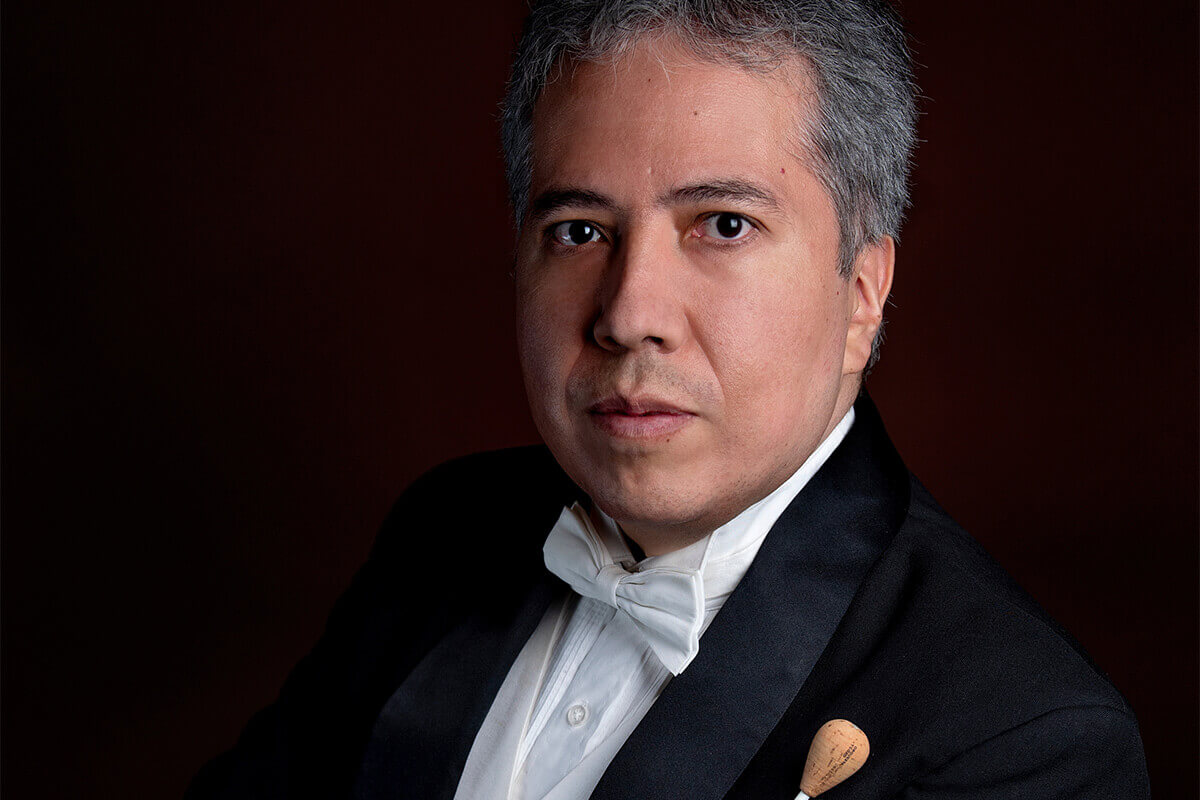Ludwig Carrasco ’99 (Bachelor of Music in Performance – Violin) was appointed artistic director and principal conductor of the National Symphony Orchestra of Mexico.
Mexico’s National Institute of Fine Arts and Literature (INBAL) has concluded the process of consultation, dialogue and definition for the new artistic director and principal conductor, as well as a new project aimed at strengthening the National Symphony Orchestra (OSN) of Mexico.
With the definition of the new artistic direction, which will now be headed by Maestro Carrasco, a new stage begins for this musical institution. The maestro was appointed by the General Director of the National Institute of Fine Arts and Literature Lucina Jiménez López, in use of the powers granted to her by the Institute’s creation decree.
“It is a very important moment for the National Institute of Fine Arts and Literature, because a new stage will begin for the National Symphony Orchestra, whose trajectory is one of the prides of this institution and of the country,” said López.
Maestro Carrasco has developed an important career at the podium of different professional music ensembles: he assumed the position of artistic director of the Bellas Artes Chamber Orchestra in September 2019, and his previous experience includes being artistic director and principal conductor of the Orquesta Filarmónica de Querétaro for five seasons, as well as principal conductor of the Sinfonietta Prometeo (United States). He equally cultivates the symphonic and operatic/ballet repertoire, as well as multidisciplinary projects, conducting stage productions of works as diverse as “Bastien und Bastienne” (Mozart), “An Index of Metals” (Romitelli), “Pierrot Lunaire” (Schoenberg), “Funny Girl” (Styne) and “Dialogues of Carmelites” (Poulenc), in addition to the world premiere of the operas “La Creciente” (Georgina Derbez), “Riesgo” (Rogelio Sosa), among many others. His interest in Mexican music and in gender inclusion, as well as diversity in the music programming, have been staples of his conducting career.
As a conductor and violinist, he has performed concerts in 30 countries in America, Asia and Europe, conducting ensembles such as the Orchestra del Palazzo Ricci, Ensemble Laboratorium, Gstaad Festival Orchestra, Sinfonietta Prometeo, Orquesta Sinfónica Nacional de México, Orquesta Filarmónica de la Ciudad de México, Orquesta Sinfónica de Xalapa, Orquesta Filarmónica de la UNAM, and the Orquesta del Teatro de Bellas Artes, among many others. He has performed at venues including the Golden Hall of the Musikverein (Austria), Wiener Konzerthaus (Austria), Salzburger Festspielhaus (Austria), Tonhalle Zürich Switzerland), Berliner Philharmonie (Germany), Gewandhaus Leipzig (Germany), Konzerthaus Berlin (Germany), KKL-Luzern (Switzerland), Rudolfinum (Czech Republic), Parco della Musica (Italy), Carnegie Hall (United States), Kennedy Center for the Arts (USA), Lincoln Center (USA), National Arts Center (USA), Lincoln Center (USA), National Arts Center (Canada), Shizuoka Hall (Japan), Auditorio Nacional de Música (Spain), Sala Nezahualcóyotl (Mexico), Teatro Teresa Carreño (Venezuela), and Palacio de Bellas Artes (Mexico), as well as in the important international festivals of Salzburg, Lucerne, Davos, Ultraschall, Gstaad, Alicante, Santander, June in Buffalo, IMPULS, Bayreuth, Spoleto, Cervantino, and Tage für Neue Musik Zürich.
He is an active promoter of contemporary music, having premiered more than 120 works to date. In this field he has collaborated with distinguished composers, such as Erik Ullman, Mario Lavista, Ignacio Baca Lobera, Manuel Martínez Burgos, Javier Torres Maldonado, Gabriela Ortiz, Georgina Derbez, Marcela Rodríguez, Hebert Vázquez, Andrea Portera and Da Jeong Choi. He attended masterclasses and workshops with Neeme Järvi, Leonid Grin, Gennady Rozhdestvensky, Kenneth Kiesler and Gustav Meier. He pursued additional studies and guidance with renowned conductors such as Mariss Jansons, Pierre Boulez, Michael Luig, Sandro Gorli, Miguel Harth-Bedoya, Alberto Zedda, David Itkin, Mallory Thompson, Gianluigi Gelmetti and Marcello Viotti.
Maestro Carrasco participated, within a group of candidates, in presenting a project for the National Symphony Orchestra in which he proposes several lines of action in accordance with the guidelines established by the National Institute of Fine Arts and Literature, and within the criteria for the revitalization of the group in a new phase, in which inclusive, social and pedagogical proposals that will benefit and strengthen ties with different communities stand out. One of the purposes is to strengthen the group’s scope of action and establish a fruitful dialogue with similar cultural institutions in Mexico and other countries.
Maestro Carrasco will conclude his cycle at the helm of the Orquesta de Cámara de Bellas Artes (Mexico’s National Chamber Orchestra) in December of this year. His tenure as head of the OCBA was distinguished by the promotion of renowned composers of the chamber orchestra repertoire, programming 76 works by Mexican composers (33.4% of a total of 227 works performed). In addition, 32 world premieres and 37 national premieres were performed. During this period, 34 artists (soloists and conductors) made their debut with the OCBA.




